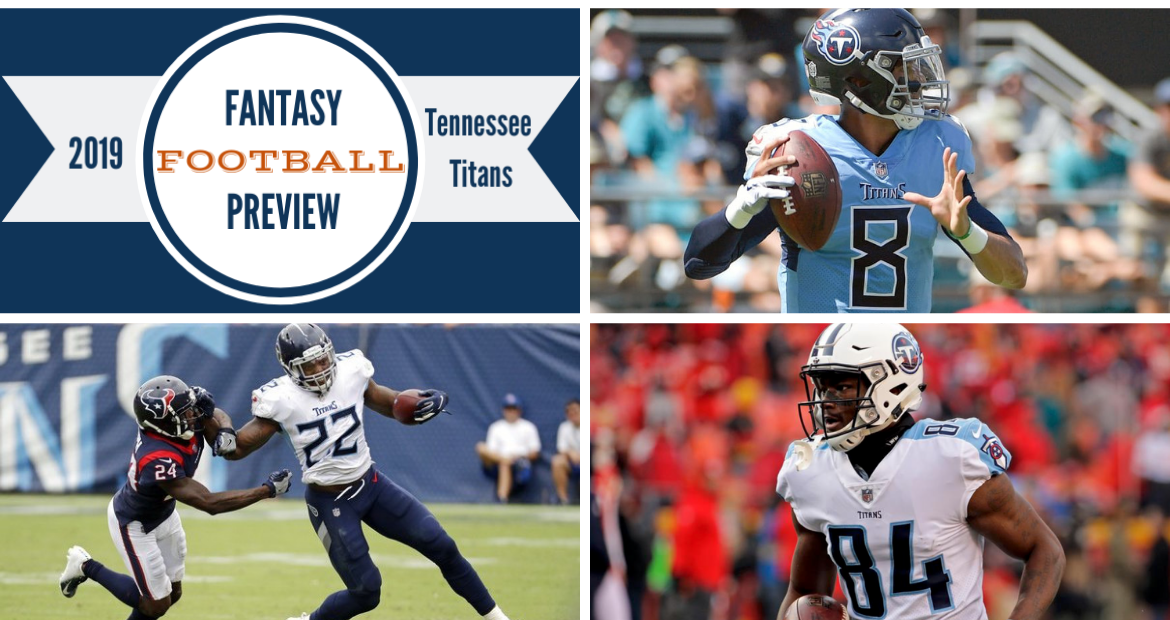
Fitz on Fantasy: 2019 Tennessee Titans Buying Guide
Successful drafting is less about picking the right players than avoiding the wrong players. Keep your shots in the fairway and stay out of the trees, ponds and bunkers.
Derrick Henry might be the Road Hole Bunker of 2019 fantasy drafts.
When he woke up on Dec. 6, 2018, Henry had 474 rushing yards and five TDs for the season. He was averaging 39.5 rushing yards per game and 3.7 yards per carry. He had produced fewer than six PPR points in eight of his 12 games, and a great many Henry owners who qualified for the fantasy playoffs had him on the bench for that night’s Week 14 game against the Jaguars and their daunting defense.
But Henry eviscerated Jacksonville that evening, carrying 17 times for 238 yards and four touchdowns in a 30-9 Titans victory, with TD runs of 99 and 54 yards. Jaguars defenders couldn’t have looked more disinterested. The Jags were about to lose their ninth game, and while they were physically in Nashville that night, mentally they were in Barbados, or Aruba, or wherever their travel agents had booked them for January vacations.
Henry detonated again the following week, rushing 33 times for 170 yards and two TDs against the Giants. He finished the regular season with rushing lines of 21-84-1 and 16-93-0 against the Redskins and Colts, respectively. (The Giants ranked 20th against the run last year, according to Football Outsiders’ DVOA metric, the Redskins ranked 28th, and the Colts ranked fourth.)
Only Seattle was more run-heavy than Tennessee last year, and the narrative is that the Titans will continue to pound the rock under new offensive coordinator Arthur Smith, who was promoted from the role of tight ends coach after former OC Matt LaFleur took the Packers’ head coaching job. But pounding the rock requires positive game scripts. The Titans had a net point differential of +7 last year and lost five games by a touchdown or more. They project to be close to a .500 team in 2019, and they may not be in position to get Henry 15-20 carries week in, week out. He had fewer than 15 carries in 10 of his games last season.
The problem is that Henry can be game-scripted into oblivion when the Titans fall behind. He’s a non-contributor as a pass catcher, with 39 receptions in 47 regular-season games. He’s averaged 7.9 receiving yards per game and has one career TD catch. Because Henry is so one-dimensional, his weekly floor in PPR and half-PPR formats is Wes Craven-level scary. Don’t attend any house showings on Elm Street, and don’t buy Henry at his current cost.
Dion Lewis had a career-high 214 touches last year and played nearly 200 more snaps than Henry, but by the end of the regular season Lewis had been relegated to passing-down/change-of-pace duty.
It used to be that the biggest concern with Lewis was health. Over a five-year span from 2012 to 2016, Lewis played only 23 regular-season games. Well, he hasn’t missed a game in the last two seasons, but he averaged a career-low 3.3 yards per carry last year and scored only two TDs. Lewis had 59 catches on 67 targets last season, so there’s still PPR value here, but he’s averaged just 6.6 yards per catch over the last three seasons, which is pretty uninspiring for a scatback.
Even if you have a healthy dose of skepticism about Henry’s 2019 prospects, it’s probably worth pumping the breaks on Lewis, too, considering the slippage in efficiency numbers and the late-season role reduction.
A name to file away as an in-season waiver wire possibility: Alex Barnes. He went undrafted, But Barnes is a 99th-percentile Spark-x athlete who thrived in a workhorse role last year as a junior at Kansas State.
Marcus Mariota has spent four years in the league and hasn’t finished a season in QB1 range yet, his high-water mark being a QB13 finish in 2016. Fantasy owners who once showed enthusiasm for the second overall pick of the 2015 NFL Draft are now turning their backs.
Three reasons to keep a candle in the window for Mariota:
1. He’s had atrocious injury luck, with a sprained MCL in 2015, a broken ankle in 2016, a strained hamstring in 2018 and a nerve problem with his throwing elbow that caused hand numbness in 2019.
2. He has 4.5 speed and averages more rushing yards per game for his career than Dak Prescott.
3. He was really good in college. Like, insanelygood. In three years at Oregon he completed 66.8% of his throws, averaged 9.3 yards per attempt, had a TD-INT ratio of 115-14, and ran for 2,237 yards and 29 TDs.
The impatience with Mariota isn’t limited to fantasy owners. Members of the Titans brass are tapping their feet and looking at their watches, too. The Titans gave the Dolphins a 2020 fourth-round pick for ex-starter Ryan Tannehill, suggesting they felt compelled to have a higher-end backup behind Mariota. But it’s too early to walk away from a quarterback who showed the sort of talent Mariota displayed in college and whose injury history is a plausible excuse for his failure to develop.
Even if Mariota steps it up in his fifth NFL season, the run-heaviness of the Titans’ offense could tamp down the potential upside. Even if the Titans get a dead-cat bounce in passing volume, they still figure to be in the bottom half of the league in pass attempts.
Mariota isn’t worth your attention in a 12-team, 16-round draft, but he could be a sneaky value in 2QB and superflex leagues, or in single-QB leagues with a lot of teams and big rosters.
Public enthusiasm for Corey Davis is waning, so maybe this is the right time to get a business-class seat on the bandwagon. The fifth overall pick of the 2017 draft, Davis had his rookie season largely derailed by a hamstring injury, but a two-TD performance against New England in the playoffs kept interest piqued going into his second season. Davis stayed healthy in 2018 but produced drab numbers (65-891-4) and wasn’t very efficient. Matt LaFleur’s Paleolithic play-calling may have had something to do with the lackluster stats, but to be fair, Davis didn’t show many unmistakable signs of impending stardom.
Still, there’s a lot to like with Davis. This is a dude who topped 1,400 receiving yards in each of his last three college seasons at Western Michigan. He’s 6-3, 209 pounds, runs well for a big receiver and checks the boxes for route-running, ball skills and hands. A season of good health for Mariota and a slight uptick in team passing volume could help propel Davis to a third-year breakout. With his ADP at WR41, the price should be right in a lot of drafts.
The Titans spent a second-round draft pick on Ole Miss star A.J. Brown, who had 160 catches for 2,572 yards and 17 TDs in his final two seasons with the Rebels. Powerfully built (6-0, 226) and fast (4.49), Brown can play inside or out, and the smart money says he’ll be a fantasy gem in a few years. It’s just hard to see him firing out of the gate quickly in a conservative offense where there’s an alpha receiver ahead of him. And while Brown canline up outside, he’s far more dangerous as a big slot man. Unfortunately, the slot in Tennessee appears to be occupied already.
Speaking of which, let’s play a quick round of the $100,000 Pyramid.
Clue-giver: “Prescription drugs … bottled water … mattresses … movie popcorn … Adam Humphries…”
“Things that are overpriced!”
Ding, ding, ding, ding
Titans GM Jon Robinson lavished a four-year, $36 million contract upon the former undrafted free agent following Humphries’ career-best 76-816-5 season for the Buccaneers. Yes, yes … NFL contracts are misleading, and Humphries surely won’t earn every last dollar of that deal. Still, he was given a $10 million signing bonus and will get $19 million guaranteed. That’s a lot of spinach for a smallish slot man who’s averaged 10.6 yards per catch for his career and has scored nine TDs in 60 career games.
For fantasy purposes, Humphries was serviceable for much of last season, but he was playing for a team that led the league in passing yardage and was fourth in pass attempts. Now he goes to a much more conservative offense that already has an alpha receiver and just took one of the top WR prospects in the second round of the draft. Expect about 50-55 low-impact receptions from Humphries and few touchdowns, which makes him unrosterable in all but the deeper leagues.
Taywan Taylor is young and athletic and could still pop at some point, but it’s gotten more crowded in the Titans’ receiver room. There’s less hope for Tajae Sharpe, who showed glimpses of promise as a rookie in 2016 but has had a wet fuse for the last two years.
Delanie Walker rattled off four consecutive seasons as a top-five fantasy tight end before breaking and dislocating his ankle in the 2018 season opener. His track record is strong, and it’s encouraging that the Titans’ new playcaller is a longtime TE coach whose promotion Walker heartily endorsed. But Walker turns 35 in August, required major surgery to fix his damaged ankle and still isn’t fully healthy by his own admission. He also has a promising young player behind him in Jonnu Smith, an athletic second-year player who had 15-214-3 over the last five games of his rookie campaign. It’s hard to feel good about the risk proposition with Walker in light of his age and the severity of last year’s ankle injury, and Smith is still just a dynasty stash.
| PLAYER | FITZ RANKING | ECR | ADP | ADVICE |
| Marcus Mariota | QB24 | QB27 | QB28 | Nibble in 2QB |
| Derrick Henry | RB22 | RB16 | RB19 | No Me Gusta |
| Dion Lewis | RB50 | RB42 | RB41 | Fade |
| Corey Davis | WR32 | WR31 | WR42 | Speculate |
| A.J. Brown | WR70 | WR73 | WR65 | Too Soon |
| Adam Humphries | WR90 | WR70 | WR72 | Haha, c’mon |
| Delanie Walker | TE14 | TE11 | TE13 | Better options |
ADP = FantasyPros.com Average Draft Position
ECR = FantasyPros.com Expert Consensus Ranking
ADPs and rankings are based on a half-point PPR scoring format



